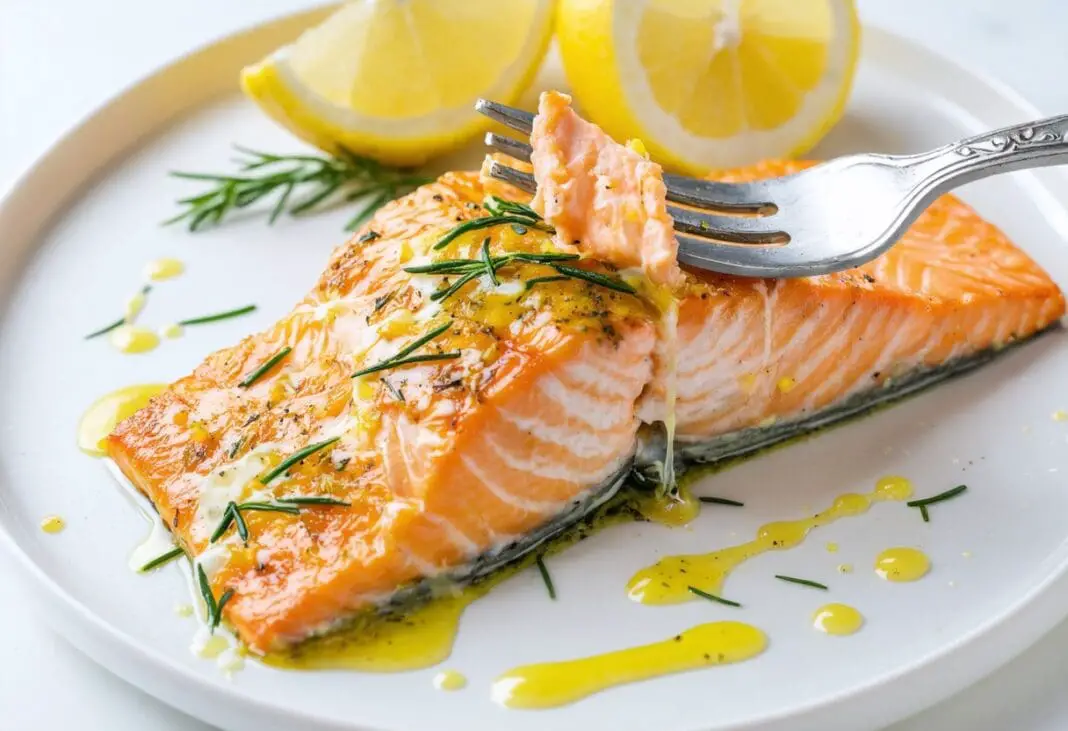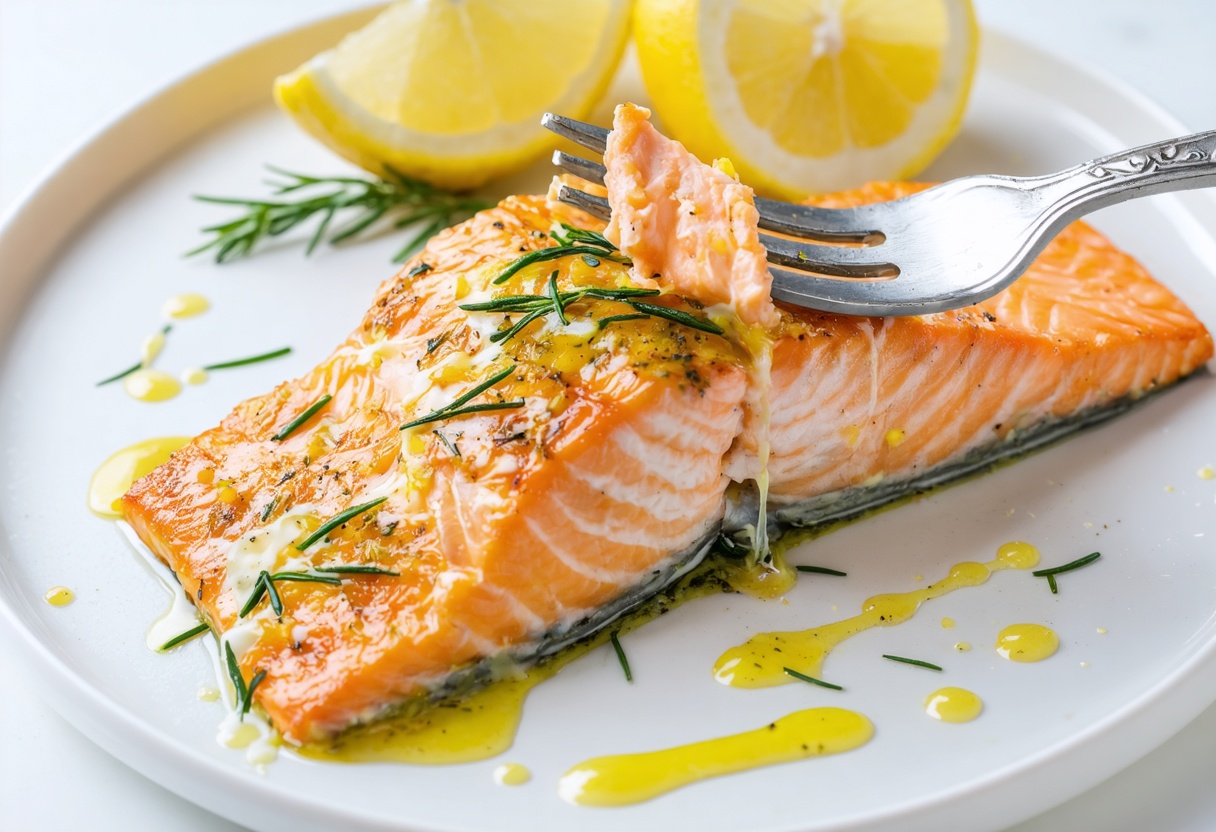Most people think salmon is impossible to cook right at home. Either it comes out dry as cardboard or still raw in the middle, and after a few disasters, many give up entirely. But what if there was a foolproof method that delivers perfectly flaky, moist salmon in just 20 minutes? The secret lies in baking at a lower temperature with a protective mayo coating that keeps everything tender and adds incredible taste.
Most people cook salmon at the wrong temperature
The biggest mistake home cooks make is cranking the oven to 400°F or higher, thinking it will cook faster. This high heat actually works against the fish, causing the proteins to seize up and squeeze out all the moisture. The result is that dreaded dry, chalky texture that makes salmon seem unappetizing. Professional chefs know that gentle, even heat is the key to perfect fish every time.
Setting the oven to 325°F might seem counterintuitive, but this moderate temperature allows the natural oils in the salmon to melt slowly into the flesh. The fish cooks evenly from edge to center, staying incredibly moist and flaky. This temperature also gives more control over doneness, so there’s less chance of overcooking even if the timer runs a few minutes long.
Mayo creates an unexpected moisture barrier
Using mayonnaise on salmon might sound strange, but it’s actually a brilliant technique that many restaurants use. The mayo acts like a protective blanket over the fish, preventing moisture from escaping during cooking. Unlike butter, which can burn at higher temperatures, mayonnaise stays stable and creates a creamy, rich coating that enhances the salmon’s natural richness without overpowering it.
Mixed with fresh lemon juice and garlic, the mayo transforms into a tangy sauce that complements the fish perfectly. The acidity from the lemon helps balance the richness while adding bright, fresh notes. This lemon mayo mixture also helps the spices stick better to the salmon, creating an even coating of herbs and seasonings across the entire fillet.
Whole fillets cook more evenly than individual portions
Many recipes call for cutting salmon into individual serving pieces before cooking, but this actually makes it harder to get consistent results. Smaller pieces cook at different rates depending on their thickness, and the edges can dry out quickly. A whole fillet, especially a thick center-cut piece, maintains more moisture and cooks more evenly throughout, giving better texture and appearance.
Center-cut salmon fillets are the thickest, meatiest part of the fish with the most fat content. This makes them ideal for baking since the extra fat keeps the fish moist and adds rich taste. Tail pieces are thinner and leaner, which means they can dry out more easily in the oven. When shopping, look for fillets that are at least 1.5 inches thick for the best results with this baking method.
Skin-on fillets stay more tender during cooking
Leaving the skin on salmon fillets isn’t just about convenience – it actually serves an important purpose during cooking. The skin acts as a natural barrier that helps seal in the fish’s oils and moisture. When baked skin-side down, the skin prevents direct contact between the delicate flesh and the hot pan, reducing the chance of sticking or overcooking the bottom.
After baking, the skin becomes loose and can be easily removed with a spatula if desired. Many people prefer to remove it before serving, and with properly cooked salmon, it practically falls off on its own. The skin also helps hold the fillet together during cooking, preventing it from breaking apart when transferring from pan to plate. This makes presentation much easier and more attractive.
Simple spices work better than complex seasonings
Salmon has a naturally rich, buttery taste that doesn’t need heavy seasoning to shine. A simple blend of dried oregano, smoked paprika, salt, pepper, and a pinch of crushed red pepper enhances the fish without masking its natural character. The smoked paprika adds a subtle warmth and depth, while oregano brings an earthy, Mediterranean note that pairs beautifully with the lemon.
The key is using spices that complement rather than compete with the salmon’s natural richness. Crushed red pepper adds just a hint of heat that awakens the palate without overwhelming it. This spice blend can be rubbed directly into the fish before adding the mayo, helping the seasonings penetrate slightly into the flesh for better distribution of taste throughout each bite.
King salmon gives the best results for baking
Not all salmon varieties work equally well for baking. King salmon, also called Chinook, has the highest fat content of any salmon species, making it incredibly forgiving and almost impossible to overcook. The extra oils keep the fish moist and tender even if it stays in the oven a few minutes longer than planned. This makes it perfect for beginners who are still getting comfortable with timing.
Coho salmon is another good choice for baking, though it’s leaner than King and requires more careful timing. Sockeye salmon is quite lean and better suited for quick cooking methods like grilling or pan-searing. If using Sockeye for this recipe, reduce the cooking time by about half to prevent it from drying out. Atlantic farmed salmon is widely available and works well, though wild varieties often have better texture and taste.
Internal temperature matters more than cooking time
While 20 minutes is a good guideline, the thickness of the salmon fillet affects cooking time more than weight. A thick center-cut piece might need a few extra minutes, while a thinner piece could be done sooner. The most reliable way to check doneness is with an instant-read thermometer inserted into the thickest part of the fish.
For medium-rare salmon, aim for an internal temperature of 120-125°F. At this temperature, the center will be slightly translucent with a silky texture. For those who prefer their salmon more cooked, 140-145°F gives a firmer, more opaque result while still remaining moist. The fish will also continue cooking slightly from residual heat after being removed from the oven, so taking it out at the target temperature ensures perfect doneness.
Preparation can be done hours ahead
One of the best features of this recipe is how much can be prepared in advance. The spice blend can be rubbed onto the salmon and the lemon mayo can be mixed up to 24 hours ahead. Simply cover the seasoned salmon with plastic wrap and refrigerate until ready to bake. This advance preparation actually helps the spices penetrate the fish more deeply, resulting in better seasoning throughout.
When ready to cook, just spread the prepared lemon mayo over the pre-seasoned salmon and pop it in the oven. This makes it perfect for dinner parties or busy weeknights when every minute counts. The advance preparation also means less last-minute rushing around in the kitchen, allowing more time to focus on side dishes or spend with guests.
Leftover salmon stays fresh for meal prep
Properly cooked salmon keeps well in the refrigerator for up to five days, making it excellent for meal prep. The moist texture from this baking method means the leftover fish won’t dry out when reheated gently in a low oven. It’s also delicious served cold over salads, mixed into pasta dishes, or used in sandwiches and wraps.
For reheating, place portions in a 275°F oven for just 5 minutes until warmed through. Avoid the microwave, which can make the salmon tough and rubbery. Cold leftover salmon makes excellent salmon salad when flaked and mixed with a little mayo, diced celery, and fresh herbs. The rich, moist texture from the original cooking method makes it perfect for these secondary uses throughout the week.
This foolproof method takes the guesswork out of cooking salmon at home. With just a few simple ingredients and the right temperature, anyone can create restaurant-quality fish that’s tender, moist, and full of rich taste. The 20-minute timing fits perfectly into busy schedules while delivering impressive results that make salmon a regular part of weeknight dinner rotation.
Foolproof Baked Salmon with Lemon Mayo
Cuisine: American4
servings5
minutes20
minutes317
kcalPerfectly moist and flaky salmon topped with creamy lemon mayonnaise and herbs, baked at the ideal temperature for foolproof results every time.
Ingredients
1 (1½-2 pound) salmon fillet, skin on, preferably center-cut
2 tablespoons mayonnaise
½-1 teaspoon finely chopped garlic
1 teaspoon fresh lemon juice
1 teaspoon dried oregano
¼ teaspoon smoked paprika
½ teaspoon kosher salt
½ teaspoon freshly ground black pepper
¼-½ teaspoon crushed red pepper, to taste
Directions
- Preheat the oven to 325°F (160°C). Line a rimmed baking sheet with parchment paper or lightly oil it to prevent sticking.
- In a small bowl, mix together the mayonnaise, minced garlic, and fresh lemon juice until well combined. This creates your lemon mayo coating.
- In another small bowl, combine the dried oregano, smoked paprika, kosher salt, black pepper, and crushed red pepper. Mix the spice blend thoroughly.
- Pat the salmon fillet completely dry with paper towels. Place it skin-side down on the prepared baking sheet.
- Sprinkle the spice blend evenly over the salmon fillet. Gently rub the spices into the flesh with your fingers or the back of a spoon to help them adhere.
- Drop spoonfuls of the lemon mayo mixture over the seasoned salmon. Use a spoon or offset spatula to spread it into an even layer covering the entire surface.
- Bake for 15-20 minutes, until the flesh feels firm when gently pressed and looks opaque throughout. An instant-read thermometer should register 120°F for medium-rare or 140-145°F for well-done.
- Remove from oven and let rest for 2-3 minutes. Squeeze fresh lemon juice over the salmon before serving. The skin should peel away easily with a spatula if desired.
Notes
- For best results, choose a thick center-cut salmon fillet rather than thinner tail pieces
- The salmon can be seasoned with spices up to 24 hours ahead – just add the mayo coating right before baking
- Leftover salmon keeps in the refrigerator for up to 5 days and reheats well in a 275°F oven for 5 minutes
Frequently asked questions
Q: Can I use frozen salmon for this recipe?
A: Yes, but make sure to thaw it completely first. Pat the thawed salmon very dry with paper towels since frozen fish releases more moisture. The cooking time might need to be reduced by 2-3 minutes since thawed salmon can cook slightly faster than fresh.
Q: What if I don’t like mayonnaise on fish?
A: You can substitute the mayo with softened butter mixed with the same garlic and lemon juice. The mayo doesn’t taste strongly of mayonnaise once baked – it just creates a creamy, protective coating that keeps the salmon incredibly moist.
Q: How do I know if my salmon is overcooked?
A: Overcooked salmon will look very opaque white throughout, feel firm and dry when pressed, and may have white protein (albumin) leaking from the surface. Properly cooked salmon should still have a slightly translucent center and feel tender when gently pressed.
Q: Can I double this recipe for a larger crowd?
A: Absolutely! You can use a whole side of salmon (3-4 pounds) and double the mayo and spice amounts. Increase the baking time to 25-30 minutes, checking with a thermometer to ensure it reaches the desired internal temperature throughout the thickest parts.


